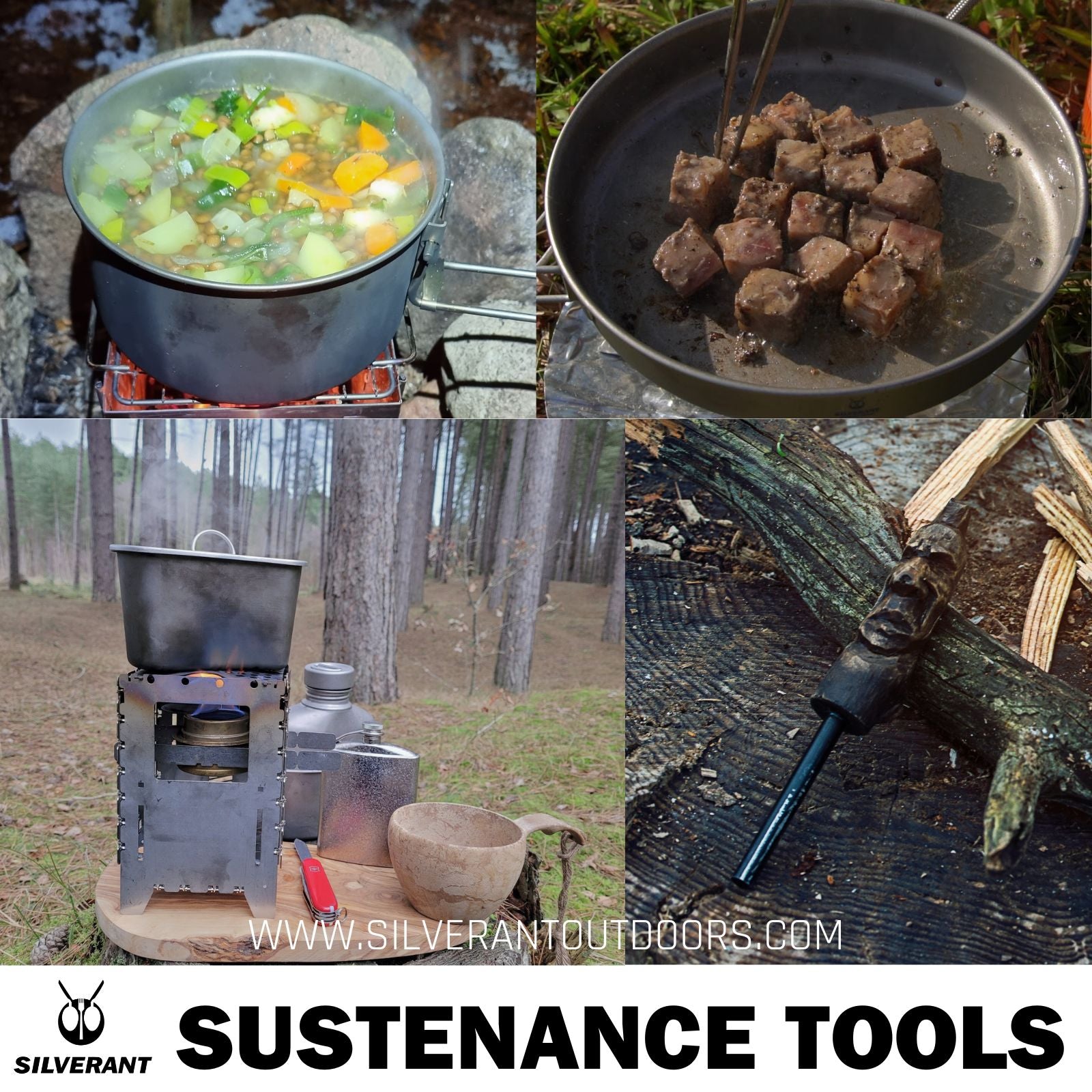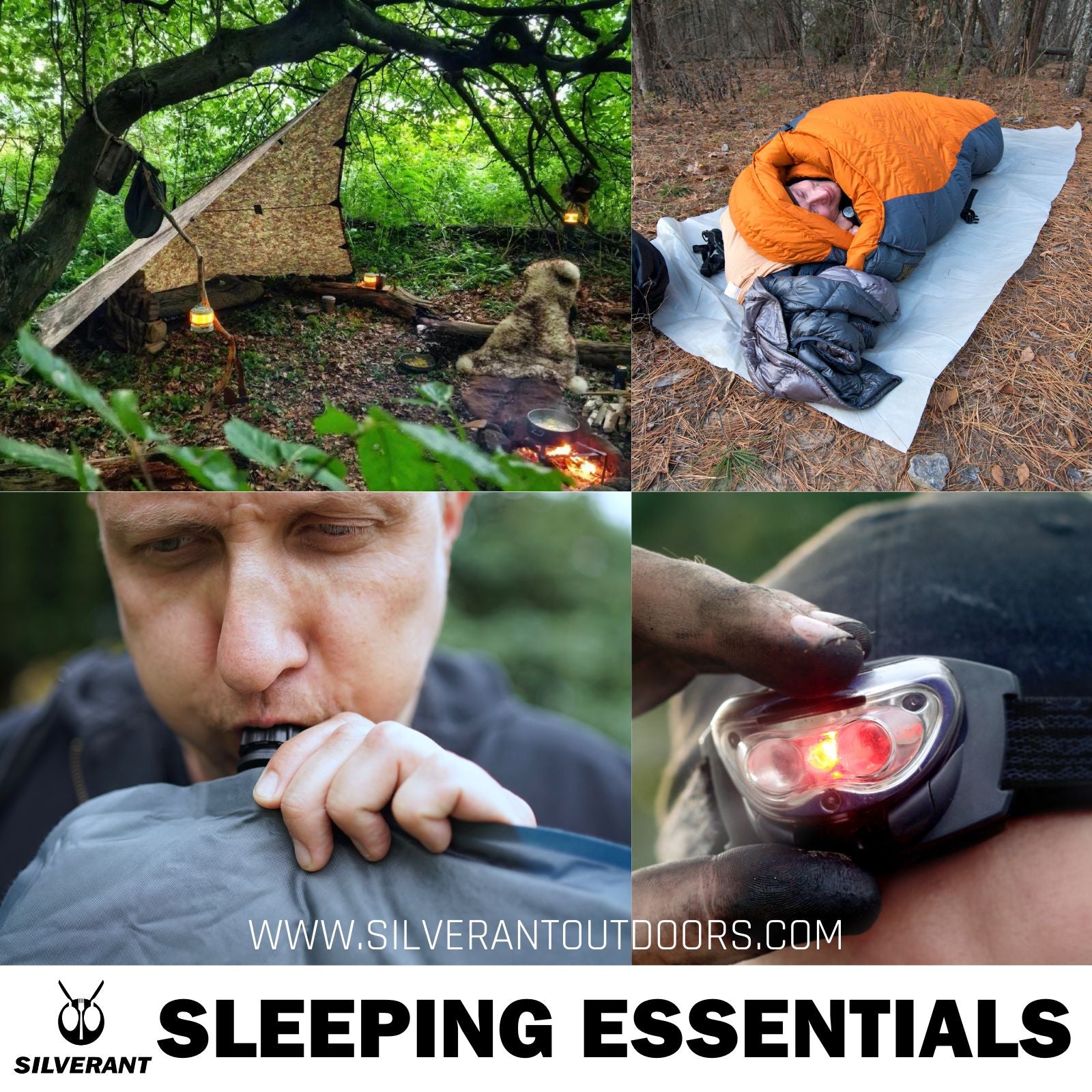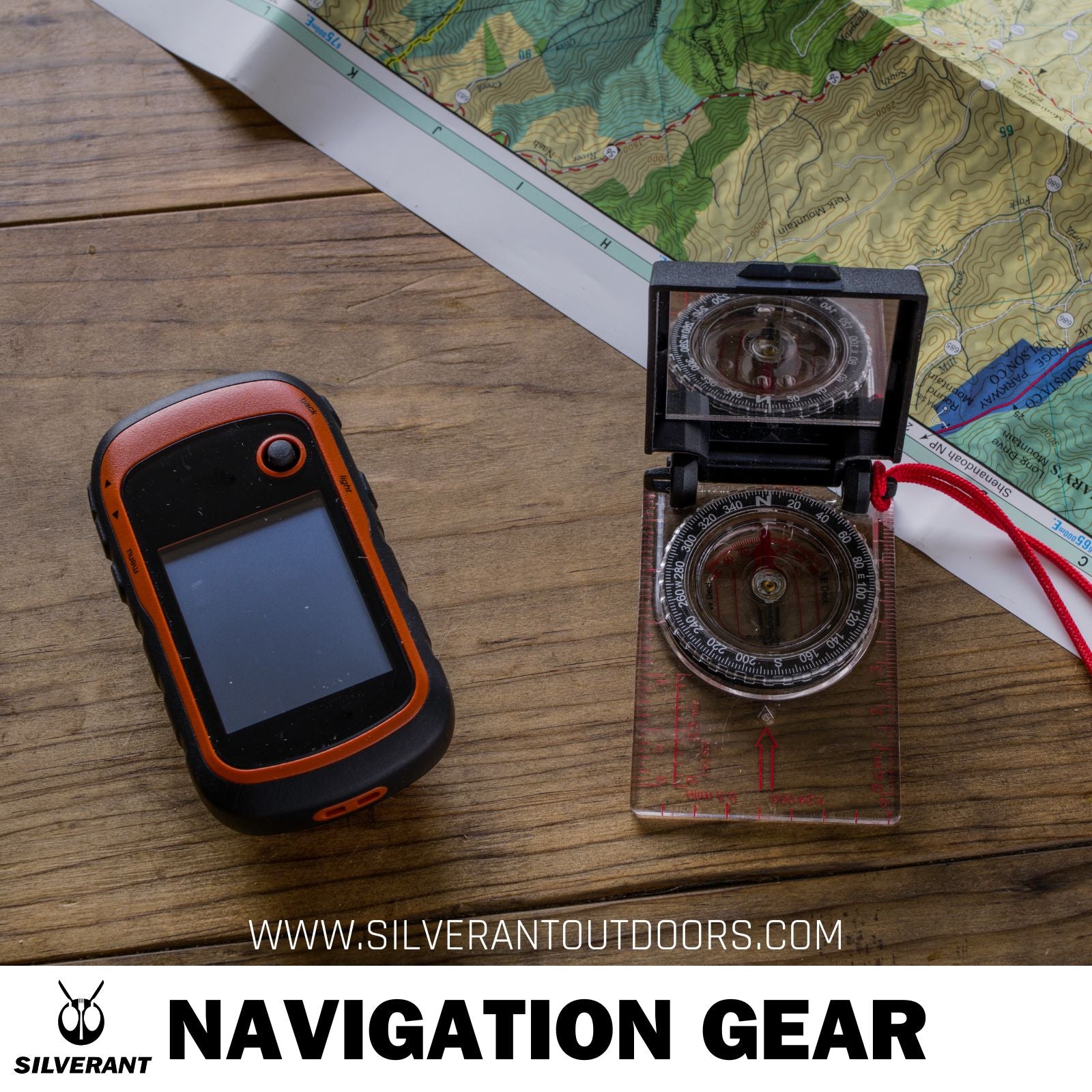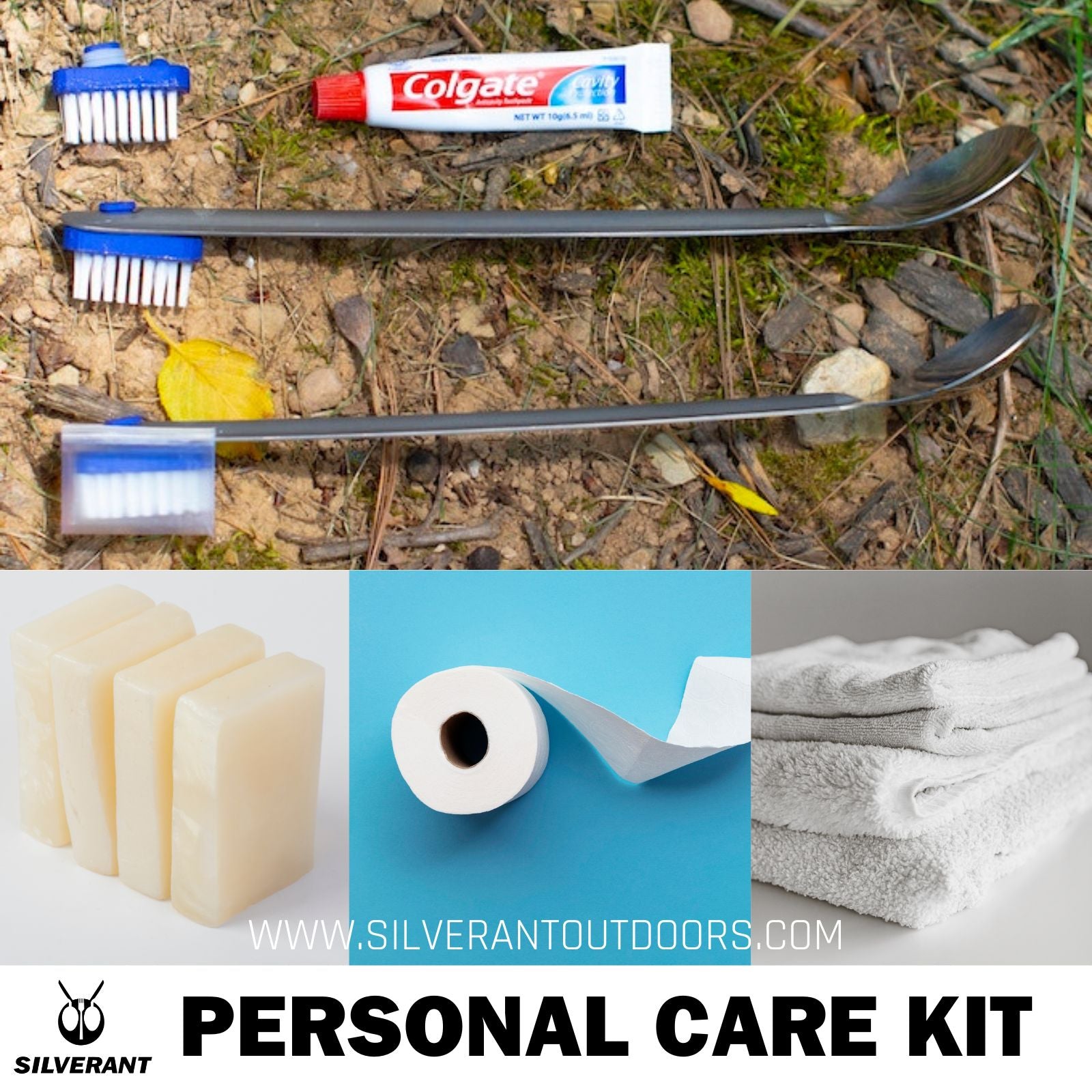Save 25% OFF

In the past three months, my first blog post about bushcraft techniques has been getting more attention, and the second one is gaining traction too.
It's pretty clear that our followers are really into bushcraft, not just hiking, camping, or backpacking.
However, bushcraft is all about working with nature more than other outdoor activities.
The tools you use have to be versatile and make the most out of what's around you.
So, in this blog post, we will dive into the 16 essential pieces of gear in my toolkit.
These have proven to be absolutely necessary and practical during my self-reliant adventures.
I've sorted them into core essentials, sustenance tools, sleeping essentials, navigation gear, and a personal care kit to keep things simple.
Feel free to pick and choose what you need to add to your toolkit, especially when you've already got some other items ready.
Core Essentials
First up are the core essentials.
I put them first because you won't easily find substitutes for these in nature, yet they are super helpful for your self-reliant bushcraft adventures.
First aid kit
Back in the day, I'd just chuck my first aid kit to the bottom of my toolkit, as you can see from my old blog posts.
But you know what changed my mind? A seriously nasty cut during one of my adventures.
After that, I realized – the first aid kit needs to be right at the top, just like it says in its name.
Even if it means using up a bit of space, believe me, it's super important.
If you end up bringing it back unopened, don't call it useless. Consider it a blessing that you didn't get hurt.
Moreover, on these days, first aid kits are usually compact and lightweight, super easy to carry.
Customize yours with essentials like bandages, wipes for cleaning wounds, pain medication, tweezers, blister aids, and any personal meds you might need.
Lastly, I'm saying it again – don't leave the kit at home, unless you're itching to try the whole stopping bleeding with a hot knife routine. Just kidding, of course.
Folding handsaw
Next, the folding handsaw is the second tool on our list of core essentials. Yeah, you heard that right.
Back when I was into camping and backpacking, I was scratching my head wondering why other bushcrafters carried it.
But let me tell you, when you're out there building a survival shelter in the woods, you'll realize how handy it is.
It's a breeze to cut all the logs you need, of different lengths and widths. Honestly, an axe doesn't shine as much in this department.
Plus, it's great for preparing wood for your fire. If your adventure is in the snowy winter, having a tent stove is a game-changer.
A handsaw makes getting the right length of firewood for your stove a walk in the park.
And here's a bonus: in emergencies, it can double as a self-defense tool.
Now, you might be wondering why it's a folding handsaw. Well, it's safer to tuck those saw teeth away, and it saves you more space. Smart, right?
Quality Knife
Coming in at number 3 is a quality knife.
Actually, no matter whose list you're looking at, it's always in the top three essentials for any bushcrafter.
At first, I only used it for cutting meat and veggies, but I soon realized it's way more versatile than that.
When you're building a shelter and need to trim excess cordage for lashing or binding, your knife comes in handy.
And once your shelter's up, you'll want tent stakes to keep it secure.
Titanium tent stakes are light and reliable, but in a pinch, you can carve out a few from wood with your trusty knife.
Plus, the leftover wood can be used as tinder for your fire.
Moreover, if you're into fishy delights, your knife can help prep the catch for cooking.
After that, you can use it to carve a fish roasting stick and fashion two Y-shaped sticks for traditional outdoor cooking.
But the usefulness of a quality knife doesn't stop there – get creative!
Now, when it comes to picking the right material for a quality knife, let me be straight with you – although we're proud of all our titanium gear, it's not the best for knife blades.
Titanium is strong, but it's more prone to breaking compared to steel.
Also, I've seen some bushcraft folks using their knives to chop big firewood, especially when they've got another piece of wood for some extra power.
So, when picking a knife, go for one made of stainless steel, Damascus steel, or carbon steel, and make sure it's got a full tang for that extra durability.
And if you're stuck between choosing a fixed blade or a folding knife, go with the fixed blade.
They're sturdier and more dependable. Just make sure to keep it sheathed when you're not using it.
One more reason to steer clear of folding knives – you definitely don't want any accidents when you're opening or closing the blade. Safety first!
Cordage
Next, just like the trusty quality knife, cordage is another must-have that's all about versatility.
Remember what we talked about earlier? When you're putting together a shelter, you're counting on cordage to tie things up.
Once that shelter's standing tall, you can get creative with cordage – crafting your own tables and chairs, a neat firewood shed, or practical drying racks. Cordage is the key player for all these tasks.
And here's a reminder of its potential lifesaving uses: you can fashion a splint or a tourniquet in emergencies.
If you're not familiar with all the cool ways to use cordage, check out our blog piece - "Beyond Knots: Harnessing the Power of Lashings and Bindings."
Now, when it's time to pick your cordage, go for the strong and durable ones.
In all my bushcraft trips, I always go for the 550 Paracord because it's tough and doesn't weigh me down.
But don't forget about the natural options like jute or hemp rope; they're just as useful.
Work gloves
Wrapping up our core essentials is work gloves, a crucial item that often gets overlooked.
Unlike hiking or camping, bushcraft involves more hands-on work with wood. So, protecting your hands is a must.
Quality work gloves act as a shield, guarding your hands from abrasions, cuts, and blisters.
Remember that nasty cut I talked about earlier? Yeah, it happened during some intense chopping because I didn't have my work gloves on.
When choosing gloves, find ones that strike a balance between durability and dexterity.
You want to be able to handle tools and materials effectively without compromising protection.
To sum it up, with these five core essentials, you've got yourself a safe and somewhat cozy spot to hunker down and keep yourself safe from injuries.

Sustenance Tools
But as humans, we can't survive without food and water. So, in this section, let's chat about the sustenance tools that'll keep you hydrated and well-fed.
Firestarter
The top tool on the sustenance tools list is a fire starter.
Whether you're looking to boil water or cook up some grub, this one's a must.
Unless you've got a stomach of steel like Bear Grylls, this gear is for the rest of us. So, make sure it's on your list.
In some of our previous blog posts, we chatted about the Bow Drill Method and the Fire Plough Method for making fire.
But when things get tough, having a flint rod alongside your trusty steel knife can be a total game-changer.
These tools make sure you can light a flame even when the weather is throwing its worst at you.
Plus, a fire can also help keep unwanted critters away.
Bushbox
Now, you've got your fire starter sorted, and making a campfire with the wood around you sounds like a plan.
It adds a cozy touch to cooking and enjoying a drink in the outdoors.
But here's the deal: in not-so-friendly weather, crafting a campfire can be a bit of a challenge. That's where a bushbox comes to the rescue.
It's a perfect alternative, making it easy to follow Leave No Trace principles and keeping Mother Nature safe from any fire risks.
When you're picking a bushbox, aim for a foldable titanium one with an ash pan.
Why? Well, it's light to carry, easy to pack, and a breeze to set up. Simple as that!
Titanium water bottle
Once your fire is crackling, the first thing you want to do is boil some water. Hydration is a big deal wherever you are.
But here's the deal in the wild – don't go sipping water straight from the river or lake. It's got bacteria and parasites that can mess you up.
You need to purify it first. We talked about using different gear for that earlier, like filters and light gadgets.
But in the bushcraft scene, keep it simple – just boil that water and toss in some purification tablets. It's an old-school trick that still works like a charm.
That's where the titanium water bottle steps in as your go-to. Unlike the plastic ones, you can boil water right in it.
And it's not just about boiling – it's lightweight and tough, unlike those heavier stainless or fragile aluminum bottles. That's the name of the game in bushcraft.
Now, let's give a shoutout to our titanium canteen – it's been a hit since day one.
And here's the kicker – it comes with a cup that can nest the bottle snugly!
So, whether you’re making a steaming cup of coffee or tea, or cooking up some soup, it's got you covered without taking up extra space.
Titanium cookware
Now, onto the food part. The key here is a balanced meal with carbs, fat, and protein – always the priority.
That's where dehydrated food comes in handy. It's balanced, easy to carry, lasts a long time, and all you need is boiling water to make it ready to eat.
So, grab a pot that's just the right size for your appetite.
But, if you're a bit tired of the dehydrated scene, switch it up with some frying action. A well-sized frying pan can be a game-changer.
For your cooking tools, a cookware set with a pot and a pan is a must.
And why titanium cookware? Same reason as the titanium water bottle – it's lightweight, durable, and perfect for your bushcraft adventures.
In a nutshell, having these four sustenance tools in your kit ensures you stay hydrated, well-fed, and keep the adventure rolling smoothly.

Sleeping Essentials
Moreover, getting a good night's sleep is just as important as staying hydrated and well-fed.
That's where these sleeping essentials come in – they'll make your shelter cozy and ensure you get that much-needed rest.
Tarp
To start, as we've stressed in our previous blog posts, tarps are a real game-changer for any outdoor adventure.
Once your shelter frame is up, a tarp can shield you from harsh sunlight or unexpected rain.
And if you're lucky, like our ambassador Marek, you might find the perfect tree to create a shelter with just a piece of tarp.
But wait, there's more! You can lay a tarp on the ground or over a wooden bed to protect your ground pad from wear and tear.
And if you're handy with cordage lashing, you can even craft a comfy bushcraft chair with it.
Picture yourself sipping coffee under the starry sky – pure bliss.
When picking a tarp, go for one that's tough, water-resistant, and has reinforced edges and attachment points. It's those little details that really make a difference.
Sleeping pad
Next up, you'll need a ground sleeping pad. This handy tool keeps you insulated from the cold or damp ground.
Additionally, a comfortable pad not only keeps you warm and dry but also provides cushioning for a better night's sleep.
That's where inflatable sleeping pads come in handy – they're light, portable, and guarantee a cozy rest.
Sleeping bag
Now, onto the sleeping bag. It's just as crucial for a good night's rest as the sleeping pad.
When choosing a sleeping bag, make sure it matches the expected weather conditions.
Remember to think about the insulation type and temperature rating when making your decision.
That way, you'll be snug and comfy regardless of what Mother Nature throws your way.
Headlamp
Last but not least, don't forget about a headlamp.
It's a lifesaver when nature calls in the middle of the night – keeping your hands free for those important tasks.
And when you're navigating through the darkness, a headlamp provides a reliable beam of light.
When picking one, go for headlamps with adjustable brightness and a battery that lasts.
Brands like Black Diamond and Petzl are known for their durable outdoor lighting.
Just remember to stash some extra batteries in your bag – you'll thank yourself later.
Now, you'll be well-prepared for a cozy and restorative night's sleep outdoors.

Navigation Gear
And after a good night's sleep and a hearty breakfast, it's time to keep on exploring.
GPS
Firstly, in today's tech world, having a GPS device is like having a super useful tool.
It helps you find your way, keeps track of where you're going, and can be a real lifesaver in places you don't know.
Plus, with two-way messaging, you can keep your friends and family in the loop and let them follow along as you explore.
And if there's ever an emergency, you can send out an SOS alert anywhere in the world.
Just remember to pack some extra batteries for your GPS, like you do for your headlamp!
Compass and Topographic map
However, even though we've got fancy GPS gadgets these days, old-school tools like a trusty compass and a detailed topo map are still super important in bushcraft.
They're like your backup plan in case your GPS decides to take a break.
And knowing how to use them really boosts your navigation skills, especially in different kinds of terrain.
But let me tell you, mastering the art of using a compass with a topo map definitely takes some practice.
If you're not sure where to start, be sure to check out our blog post "Navigating the Wild" for some handy tips on bushcraft land navigation.
So far, your bushcraft adventures are nearly all set with these 15 must-haves in your toolkit.

Personal Care Kit
And the final piece of the puzzle is your personal care kit.
In the wild, staying clean is super important because there are more germs floating around.
Pack things like soap, a toothbrush, toothpaste, a small towel, and tissues to keep yourself fresh.
And when it comes to soap, go for the biodegradable kind. Each of us should look after Mother Nature while we're out there.
Conclusion
To wrap it up, heading out on a bushcraft adventure is a blast, but it means being smart about the gear you take.
With the core essentials like a first aid kit, handsaw, knife, cordage, and work gloves, you're set to stay safe and create a cozy spot to relax.
Keep the energy flowing with tools like a fire starter, bushbox, titanium bottle, and titanium cookware for staying hydrated and well-fed during your adventure.
For a good night's sleep, grab sleep essentials like a tarp, sleeping pad, sleeping bag, and a headlamp.
Include navigation gear like GPS, a compass, a topo map, and a personal care kit, and you've got a total of 16 pieces to ensure a safe and enjoyable adventure.
But remember, building your bushcraft toolkit is a personal journey that keeps evolving.
Customize it as you keep exploring the outdoors. And feel free to share your toolkit in the comments or shoot us a message!
To your next adventure
Steve













































